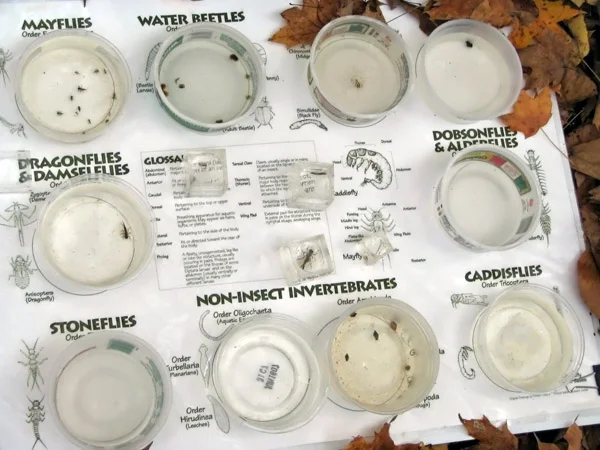Stream Explorations - Recommended for Grades 6 -8
Recommended for grades 6 - 8. Water quality assessment through chemical testing, measurement of physical parameters, and observation of biological indicators (macroinvertebrates) provides students with opportunities to collect, analyze and report upon authentic data. An afternoon TeachCam session affords students the opportunity to view specimens in a "larger than life" format. Life cycles and adaptations will be covered.
Fee:
$16 per student ($160 minimum per class)
Contact: PWC Education Department at education@perkiomenwatershed.org
What the Teachers Are saying…
“Thank you so much for providing my students with such a wonderful and meaningful experience. Your enthusiasm is not only remarkable, it is contagious. The kids loved this field trip - it was described countless times as their "favorite" or "the best!” Both the kids and the parents are raving about this trip."
- Teacher, Upper Perkiomen Middle School
What the Students are Saying…
"Thank you so much for allowing us to come to the Watershed. It was a lot of fun going into the water and collecting macroinvertebrates and doing the other activities. Thanks!
-7th grade student, Upper Perkiomen Middle School
"Thank you so much for making learning fun! I had so much fun measuring the water and looking for macroinvertebrates! Thank You!
- 7th grade student, Upper Perkiomen Middle School
"Thank you so much for the funnest field trip that we have ever taken! Even though the creek was cold we had an awesome time!!
- 7th grade student, Upper Perkiomen Middle School
“I liked finding the animals the best then looking at them under a microscope. The field trip was great!
- 7th grade student, Upper Perkiomen Middle School
PDE Academic Standards covered by this program include…
4.2.6.A - Identify the five major watersheds of Pennsylvania.
4.2.6.B - Describe the characteristics of soils found in a wetland.
4.2.6.C - Identify natural and human-made factors that affect water quality.
3.1.6.A2 - Describe how energy derived from the sun is used by plants to produce sugars (photosynthesis) and is transferred within a food chain from producers (plants) to consumers to decomposers.
3.3.6.A4 - Describe how water on earth cycles in different forms and in different locations, including underground and in the atmosphere.
3.1.7.A2 - Describes how organisms obtain and use energy throughout their lives.
4.1.7.A - Describe the relationships between biotic and abiotic components of an ecosystem.
4.1.7.D - Explain how biological diversity relates to the viability of ecosystems.
4.2.7.A - Explain how water enters, moves through, and leaves a watershed. Explain the concept of stream order. Describe factors that affect the flow and water quality within a watershed
4.2.7.B - Explain the primary functions of a wetland within a watershed. Providing habitat, flood control, water purification. Serving as buffer zones, wildlife propagation areas, and food and fiber systems
4.2.7.C - Use appropriate tools and techniques to analyze a freshwater environment. Interpret physical, chemical and biological data as a means of assessing the environmental quality of a freshwater environment.
4.5.7.C - Explain how human actions affect the health of the environment.
4.2.8.A - Describe factors that affect the quality of ground and surface waters.
4.2.8.B - Explain the value of wetlands to other living things.
4.5.8.A - Explain how Best Management Practices (BMP) can be used to mitigate environmental problems.
4.5.8.C - Describe how humans can reduce pollution.
4.2.10.A - Examine the interactions between abiotic and biotic factors within a watershed. Describe how topography influences the flow of water in a watershed. Describe how vegetation affects water runoff. Investigate and analyze the effects of land use on the quality of water in a watershed
4.2.10.C - Explain the relationship between water quality and the diversity of life in a freshwater ecosystem.







